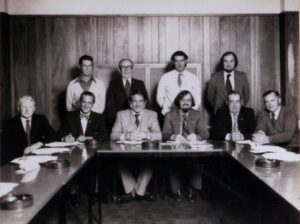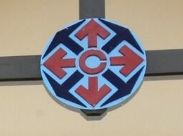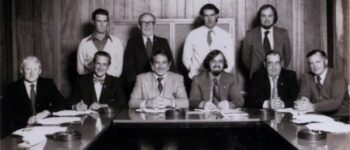1972: Masterton Cosmopolitan Club
August 23, 2024
By AHNZ
 Masterton Cosmopolitan Club (1972-2016) is a good example of a number of working men’s club style establishments of its day. From the photos we have of the founders they were evidently middle aged Silent Generation with a few adult Boomers. The Silents present themselves as pleasant with short hair and one of them, Mr Holland, even has a bow tie. The Boomers look eager and wild with side burns and interesting long hair arrangements. Because clubs like these were generational institutions they started running aground as those population cohorts dwindled. By the 2010s this Club was cutting back services, in debt, renting out its space, open to freedom campers, in denial, and finally…dead.
Masterton Cosmopolitan Club (1972-2016) is a good example of a number of working men’s club style establishments of its day. From the photos we have of the founders they were evidently middle aged Silent Generation with a few adult Boomers. The Silents present themselves as pleasant with short hair and one of them, Mr Holland, even has a bow tie. The Boomers look eager and wild with side burns and interesting long hair arrangements. Because clubs like these were generational institutions they started running aground as those population cohorts dwindled. By the 2010s this Club was cutting back services, in debt, renting out its space, open to freedom campers, in denial, and finally…dead.
In a post-mortem indignity the club’s bronze plaque once entrusted to local government archives turned up in a local scrapyard! Masterton District Council had flogged it off for $160.00 in 2023. Discovering this, old Club members recovered it at their own expense for $340.00. How many times do New Zealanders need to re-learn never to entrust their heritage to government?
“The 34-kilogram bronze plaque was commissioned in 1976 to commemorate the opening of the new Masterton Cosmopolitan Club building. When the club closed in 2016, the plaque was entrusted to the archive, which is managed by Masterton District Council…In May last year, former members of the club found the plaque at a local scrap dealer and bought it back for $340. “It’s a part of Masterton’s history, which we need to retain,” former member Paul Foster said.” – front page, Wairarapa Times-Age (23 August, 2024)
The Club thrived during an era of pub culture. The plan was hatched by messers Lewis Thompson-Milne and Alan Stewart who called on others to form a steering committee. According to William Forster he and the other 5 originals met in his home and from there advertised to build a club. Ref. Forster, Old Friends Archive
These large club rooms were opened on 27 November 1976 and according to the plaque the recently elected local MP Ben Couch (National) was there to cut the ribbon. They had live bands, impressive meal deals, smoking, gambling machines, dancing, dining, drinking. Lots of socialisating, mourning, birthdays, weddings, deals, plans, welcomes, farewells, etc. will have been facilitated in style over the 44 years this club served its community.
“Young ones don’t tend to go out till late, which doesn’t fit into the club’s timetable..At this stage, the club is a bit out of fashion.” – Alan Stewart, Treasurer. Ref Herald (2015)
“The council confirmed approval to remove the item from the collection was not given by the library and archive manager, members of the club were not contacted before the plaque was sold, and the donation of the item to another suitable institution was not considered before it was sold. “A mistake was made regarding the cor. rect process to follow,” Haines said of the plaque’s sale. The council has reimbursed the costs of buying the plaque back from the scrapyard. ‘The plaque is now installed at the Horse shoe Club, which was founded by members of the former Cossie Club.” – front page, Wairarapa Times-Age (23 August, 2024)
“For about five years it’s slowly been getting harder…Factors leading to the club’s imminent closure included the decline in membership, stricter drink-driving laws, and an aging population. “We have an average age of about 69 and the members aren’t drinking like they used to 20 years ago. “We’re not getting younger people in to replace those who are leaving or getting older. “Younger people just don’t seem to want to join these sorts of places anymore.” – Tears at Cossie Club closure, Wairarapa Times-Age (2016)
” That old Conformity was quite functional for New Zealand. Men and women got to self-medicate with drink and smoke, the brewing and tobacco businesses got rich and put proceeded toward local sport and community received funding. But these patrons were getting older in the 80s so the market was shrinking.” – Ref. 1993: Bailey’s 818, AHNZ
“As a young fulla all u get in their is eyeballed from all the old guys as soon as u walk in. Like wtf u doing in here??”
“Young people are looked down soon in these places”
“Unfortunately they had younger people over 30 years ago who were keen ,as I was in my mid 20’s but no one at the time would nominate me as you needed one too, my application was turned down, as well as others, we were considered as young hoons, now I’m heading towards 50’s, and see its going to be closed, unfortunately they should have allowed anyone and everyone maybe they would of had a rising membership numbers to keep the club flourishing limited membership numbers, loss of business”
“Unfortunately they r outa touch with what younger people like doing socially. They are still stuck in the 1980s and havn’t moved out of it”
“Young People dont join the mstn cozzie because they dont premote anything for young people.” – Comments to Wairarapa Times-Age, Facebook (2016)

Gen X, Millennials, and even some Zoomer generation would have known clubs like these but generally not as members. Kids got to play around the feet of their parents but never, even in middle age, could they inherit. Part of the purpose of any group like this isn’t just to belong but to exclude. Young people also have their own reasons not to join this old framework and try to belong to it but to find territory that belonged to them and excluded their elders. Ref. 1993: Bailey’s 818, AHNZ
This style of club was an organ in a previous version of New Zealand’s corporate organism. It had itself replaced and displaced the generations that came before it in a cultural hegemonic contest that is both disruptive but also essential to a living, thriving, continuity. To find a way for the club facilities to survive and go on being useful would have been a great achievement of passing on heritage. This is something seldom achieved and always impressive to me. Usually an old institution dies a slow death through phases of being a second-hand shop, a gang pad, a derelict, and eventually demolished as an unsafe building so the land and materials can be recycled.
I recently watched on live TV the appalling film Xanadu (1980) which tried to make a peaceful and friendly transition of one of these great old dying institutions. Gene Kelly’s 1940s character partnered with Olivia Newton-John’s 1970s to bring a huge club back from the brink and in a way that would include both sectors. It was an artistic way to solve this problem that New Zealanders also faced. An attempt as a sort of peace treaty where everyone could belong rather than be exiled to an out-group the way Robert K. Merton’s Social Structure and Anomie (1938) showed they tend to do. One day your the Conformity Group, the next you’re relegated to one of the Reject catagories (Ritualism, Retreatism.) Xanadu failed badly in its ambition even to do this in a film let alone laying a template for us to do this in life.
Every generation’s institutions crumble and are replaced by the next the way Masterton Cosmopolitan Club was. Despite the idea, or word, ‘cosmopolitan’ it’s in the nature of such things to exclude. If an entity doesn’t define what it isn’t then it doesn’t really exist. Inclusivity is a non sequitur. If New Zealanders don’t have functional institutions with in-group preferences then we will be replaced in our own country by groups that do. This is already happening as our birthrates fall and we import more migrants in to pay off the debts of our over-spending governments!
However, there is reason to be concerned that this process of ‘creative destruction’ can itself be interrupted. If Generation X eschewed any form of a Xanadu and Millennials refuse to become members of their local RSA or the Masterton Cosmopolitan Club that’s fine. Generations always do. But then they set up institutions of their own as the essential gathering places from which to organise community life. However, this does not appear to be happening. Instead, New Zealanders seem to stay home with their screens rather than be drawn to larger venues to be entertained and to coordinate. They believe, because the government has told them, that community matters are to be registered and funded by The State not themselves. Government is even turning libraries into community “hubs” which displaces the private institutions Kiwis used to create and fund themselves freely. The drive to connect with others and struggle to care for one another is diverted by simulated versions such as in shows and video games. Why should anyone work to get dopamine and serotonin from knowing and working with their neighbors when you can get so much more with less bother playing video games and sucking on vape devices?
 So the worry isn’t so much that we’ve lost something like a the Masterton Cosmopolitan Club but that we’ve lost spontaniously-generated self-organized community spaces per se.
So the worry isn’t so much that we’ve lost something like a the Masterton Cosmopolitan Club but that we’ve lost spontaniously-generated self-organized community spaces per se.
Suppose we need to overthrow a corrupt state electorally or otherwise. Then, instead, we sublimate that urge because someone writes a new popular online game that everyone plays and discharges their strong feelings into. The pixels absorb our pathos and our real world tyrants keep on exploiting us!
These founders of the Cosmo Club had a sort of Matrix-like dream world of smoke, drink, gambling, food, etc. too. However they were also functional in the real world in a way that a film studio or games developer is not. The men in the photo built things, catered to thousands, paid bills, employed people, engaged with the community in a way that California-based tech firms do not do for New Zealand. Put it this way: Would you rather be stuck in a tight situation with these men or with your local Dungeons & Dragons regulars? Or your Discord Friends List? And I don’t mean a tight situation in Minecraft or Fortnite. I mean keeping New Zealand going in the real world of electricity, industry, hospitals, clean air, education, fertility, food, shelter, defense,…
The Cosmopolitan Club engaged with the real world for generations and now that plaque is one of the few things to remind us of this if we know how to interpret it. Masterton District Council has no idea what it flung away. Does anyone?
—
Image ref. Masterton Cosmopolitan Club Inc Executive Committee 1973-74, Wairarapa Archive; Digital NZ
Image ref. Club logo. Lifted from NZ Herald article (Lynda Feringa)
Ref. also Masterton Cosmopolitan Club Inc. Steering Committee, ibid
2 thoughts on "1972: Masterton Cosmopolitan Club"
Leave a Reply
 Like Comment Share
Like Comment Share






Well said, a cause for reflection, that’s for sure. I recall in probably the eighties Auckland art gallery sold off a lot of unwanted mostly Victorian paintings,They did not say donated paintings but I believe most were donated.Over time have seen other selloffs such as downsizing and need for income to keep going. That led me to the position of selling “treasures”, a willing buyer will value and protect your stuff.
Free market for the win!